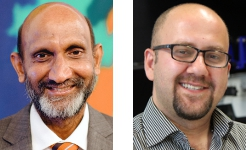Light–Matter interactions on the nanoscale

Australian National University
Nano-optics has become a very efficient tool to control light–matter interactions beyond the diffraction limit. The understanding of the optical response from individual and coupled nanoparticles has led to unprecedented development in a wide spectrum of scientific disciplines, ranging from molecular optics and biology, to nonlinear spectroscopy and clean energy. Research in the field of nano-optics now presents an opportunity to build on the existing work and establish novel directions for this area of research. Related to this goal, this Thematic Series covers various interactions between light and matter occuring on the nanoscale including:
- Metallic & plasmonic nanomaterials
- Dielectric and semiconductor nanostructures
- Nonlinear nano-optics
- Nearfield optics
- Optofluidics
Light–Matter interactions on the nanoscale
- Mohsen Rahmani and
- Chennupati Jagadish
Beilstein J. Nanotechnol. 2018, 9, 2125–2127, doi:10.3762/bjnano.9.201

Laser processing of thin-film multilayer structures: comparison between a 3D thermal model and experimental results
- Babak B. Naghshine and
- Amirkianoosh Kiani
Beilstein J. Nanotechnol. 2017, 8, 1749–1759, doi:10.3762/bjnano.8.176

Design of photonic microcavities in hexagonal boron nitride
- Sejeong Kim,
- Milos Toth and
- Igor Aharonovich
Beilstein J. Nanotechnol. 2018, 9, 102–108, doi:10.3762/bjnano.9.12

High-contrast and reversible scattering switching via hybrid metal-dielectric metasurfaces
- Jonathan Ward,
- Khosro Zangeneh Kamali,
- Lei Xu,
- Guoquan Zhang,
- Andrey E. Miroshnichenko and
- Mohsen Rahmani
Beilstein J. Nanotechnol. 2018, 9, 460–467, doi:10.3762/bjnano.9.44

Valley-selective directional emission from a transition-metal dichalcogenide monolayer mediated by a plasmonic nanoantenna
- Haitao Chen,
- Mingkai Liu,
- Lei Xu and
- Dragomir N. Neshev
Beilstein J. Nanotechnol. 2018, 9, 780–788, doi:10.3762/bjnano.9.71

Theoretical study of strain-dependent optical absorption in a doped self-assembled InAs/InGaAs/GaAs/AlGaAs quantum dot
- Tarek A. Ameen,
- Hesameddin Ilatikhameneh,
- Archana Tankasala,
- Yuling Hsueh,
- James Charles,
- Jim Fonseca,
- Michael Povolotskyi,
- Jun Oh Kim,
- Sanjay Krishna,
- Monica S. Allen,
- Jeffery W. Allen,
- Rajib Rahman and
- Gerhard Klimeck
Beilstein J. Nanotechnol. 2018, 9, 1075–1084, doi:10.3762/bjnano.9.99

The electrical conductivity of CNT/graphene composites: a new method for accelerating transmission function calculations
- Olga E. Glukhova and
- Dmitriy S. Shmygin
Beilstein J. Nanotechnol. 2018, 9, 1254–1262, doi:10.3762/bjnano.9.117

New 2D graphene hybrid composites as an effective base element of optical nanodevices
- Olga E. Glukhova,
- Igor S. Nefedov,
- Alexander S. Shalin and
- Мichael М. Slepchenkov
Beilstein J. Nanotechnol. 2018, 9, 1321–1327, doi:10.3762/bjnano.9.125

Tailoring polarization and magnetization of absorbing terahertz metamaterials using a cut-wire sandwich structure
- Hadi Teguh Yudistira,
- Shuo Liu,
- Tie Jun Cui and
- Han Zhang
Beilstein J. Nanotechnol. 2018, 9, 1437–1447, doi:10.3762/bjnano.9.136

Excitation of nonradiating magnetic anapole states with azimuthally polarized vector beams
- Aristeidis G. Lamprianidis and
- Andrey E. Miroshnichenko
Beilstein J. Nanotechnol. 2018, 9, 1478–1490, doi:10.3762/bjnano.9.139

Cathodoluminescence as a probe of the optical properties of resonant apertures in a metallic film
- Kalpana Singh,
- Evgeniy Panchenko,
- Babak Nasr,
- Amelia Liu,
- Lukas Wesemann,
- Timothy J. Davis and
- Ann Roberts
Beilstein J. Nanotechnol. 2018, 9, 1491–1500, doi:10.3762/bjnano.9.140











































































